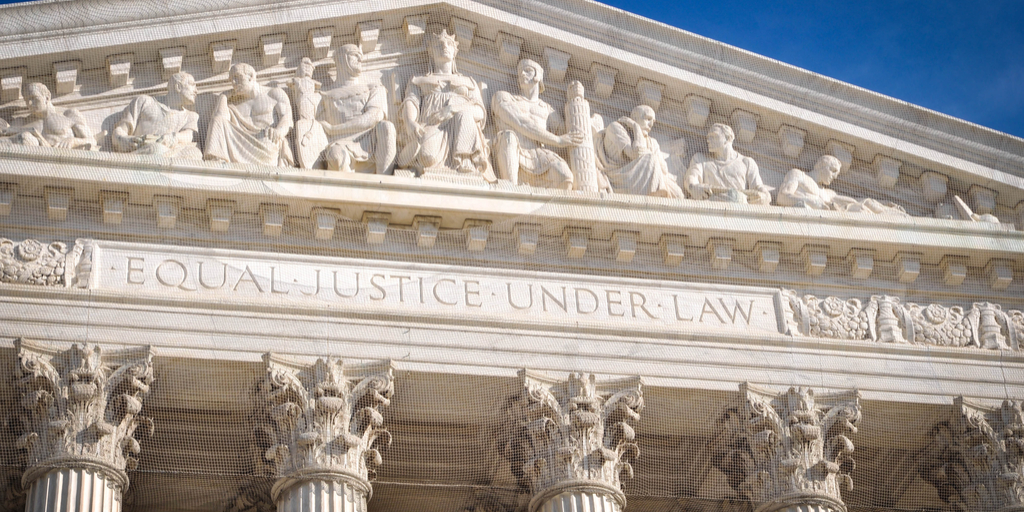Immigration Cases Make Strange Bedfellows. But Is It a Long-Term Relationship?
The big news at the Supreme Court last week was that Justice Neil Gorsuch seemed to make some new friends. In an immigration case with important long term implications, Justice Gorsuch voted with the four liberal justices (Breyer, Ginsburg, Kagan, and Sotomayor) to invalidate a crime-based deportation provision because it was void for vagueness, and thus unconstitutional.
The optics of this new alliance on the High Court generated a great deal of confused excitement in the media. Almost immediately two major distortions took hold. First, that Gorsuch’s decision in this case was surprising. Second, that this decision was a rebuke to President Trump by the justice who he had placed on the Court.
There should have been no surprise. Gorsuch’s reasoning in this case was entirely predictable given the opinions he had issued less than two years earlier when he was a circuit court judge. Nor should anyone have been shocked that he could be persuaded to rule in favor of an immigrant fighting deportation. He did exactly that in his most notable decision as a lower court judge, the one which probably earned him his nomination to the Supreme Court.
This decision also should not be thought of as a blow specifically to the Trump agenda, given that it began under the Obama Administration. The case will be remembered as Sessions v. Dimaya, but that is only because current Attorney General Jeff Sessions subbed in for his predecessor. Back in 2016, when the case was known as Lynch v. Dimaya, it was the Obama Justice Department that asked the Supreme Court to put the case on its docket.
Nevertheless, the Trump Administration was not pleased by the result, and issued alarmist warnings in response. The Department of Homeland Security issued a statement declaring: “By preventing the federal government from removing known criminal aliens, it allows our nation to be a safe haven for criminals and makes us more vulnerable as a result.” It is true that the ruling will prevent the deportation of some legal residents who have felony convictions. But it is not clear exactly how many cases will be directly affected, for two reasons. First, immigrants who enter the country illegally or who overstay visas can usually be deported even if they do not have a criminal conviction. Second, this decision only struck down one of many criminal grounds that can lead to the deportation of a legal resident. DHS can still seek the removal of legal immigrants who have convictions for crimes involving moral turpitude, felony crimes of theft, burglary, sexual abuse of children, domestic violence, rape, and any felony that involves violence or threats of “physical force against the person or property of another.” That’s just a partial list of deportable crimes left untouched by the Dimaya decision.
How the Government Lost Dimaya
Dimaya is a milestone simply because the Court struck down a provision of immigration law. That has not happened often in American history. At a minimum, this is yet another indicator that the Supreme Court sees real constitutional limits on federal power over immigrants inside the United States, especially in terms of due process of law. But that’s just the start of it. Dimaya has the potential to be a foundation for even bigger milestones in the future — especially if Gorsuch and his new friends can find a way to forge a sustainable liberal-conservative alliance. To understand why that is possible, we have to get into the weeds of what this case was actually about.
Sessions v. Dimaya concerned a catch-all definition of a crime of violence that would make deportable an immigrant who was convicted of a felony “that, by its nature, involves a substantial risk that physical force … may be used.” That is different from crimes like assault with a deadly weapon, where violence is intrinsic to the crime itself. The problem with the catch-all definition is almost any criminal activity could conceivably lead to violence. For example, if a person tries to steal someone else’s handbag, it might conceivably lead to a physical struggle, but that’s not part of the definition of the crime of theft. In a previous decision by Justice Scalia, the Supreme Court had invalidated — in a criminal case — a very similar catch-all definition of a crime of violence as void for vagueness.
The critical question the Supreme Court faced in Dimaya was whether the same constitutional vagueness standard applied in the immigration context. This is the question that forged a tenuous alliance between Gorsuch and his four liberal colleagues.
The government’s primary argument was that the vagueness standard should be more relaxed in an immigration context than it would be in a criminal case because deportation is a civil matter. In Dimaya, the majority of the Supreme Court found the civil-criminal distinction unpersuasive. That may be a big deal. For more than a century, the civil-criminal distinction has been the primary justification for limiting immigrants’ due process rights. This is the argument usually given to explain why immigrants facing deportation do not get appointed counsel to defend themselves in Immigration Court, for example. And yet, Justice Gorsuch referred derisively to “the happenstance that a law is found in the civil or criminal part of the statute.” To be clear, this case was only about the void for vagueness question. But look for that line to be quoted many times in briefs arguing for more expansive due process protections for immigrants challenging the Department of Homeland Security.
The Elephant in the Room
The potential implications of Dimaya go well beyond immigration. This is illustrated by the way in which Gorsuch and the other four justices in the majority did not agree completely. Justice Kagan (no relation to this author) wrote that the civil-criminal distinction did not help the government because the “grave nature of deportation” required the more stringent standards normally used in criminal cases. But Justice Gorsuch did not sign that part of the opinion. Writing only for himself, Gorsuch agreed about the severity of deportation. But he objected to the implication that deportation is unique: “grave as [deportation] may be, I cannot see why we would single it out for special treatment when so many civil laws today impose so many similarly severe sanctions.”
Why could these justices not come together, when they seemed at least to agree about the case in front of them? There is an elephant in the room here, and its name is Chevron deference. Before he reached the Supreme Court, Justice Gorsuch was best known for critiquing this rule, which requires judges to defer to executive branch agencies about how laws enacted by Congress should be interpreted. Chevron deference does not normally apply to criminal statutes, which is why Justice Gorsuch’s broad attack on the civil-criminal distinction is, as George Will wrote, “a scythe sharp enough to slice through many practices of the administrative state.” But this may also be why Justice Gorsuch could not convince any of his colleagues to sign onto his opinion. While Chevron increasingly has critics on the Court, it is not clear how many of the justices are yet ready to blow up the central doctrine of modern administrative law, especially in a case that does not require doing so.
I have written before in this space that immigration cases offer an opportunity to build a bridge between conservative critics of Chevron and liberal jurists who normally might be predisposed to defend it. Dimaya shows this potential, but also the challenges to building a durable left-right alliance on this issue. By seeming to want an exception just for deportation cases, Justice Kagan could be accused of promoting a form of immigration exceptionalism. But Justice Gorsuch could be accused of being too greedy. He seemed to be demanding that his colleagues agree to a sweeping ruling applicable in nearly all civil contexts, when the case before them in fact only concerned only one such context.
It would have been helpful if Justice Kagan had been willing to say more clearly that deportation is one example where the civil-criminal distinction is unpersuasive, but it might not be the only example. That might have left more room for Gorsuch to sign on. And it would have been helpful if Gorsuch had been more willing to proceed case by case, as judicial restraint dictates. That would have been a principled and modest approach for both sides, but they couldn’t quite get there.
But this is just the beginning. Tests of this relationship will come very quickly. On Monday, the Supreme Court heard arguments in another immigration case where Chevron deference is the central issue, Pereira v. Sessions. I have written elsewhere that the Court tends to apply Chevron in certain kinds of immigration cases, but not in others, but typically without announcing a clear rule about why it is doing so. This case gives Justice Gorsuch another opportunity to press his colleague to directly reconsider Chevron. An even more dramatic test may come through the many cases in lower courts challenging the way immigration arrests are carried out today. A straight-forward application of the Fourth Amendment as it applies in criminal contexts would say that many, if not most, immigration arrests are unconstitutional because they are not backed by judicial findings of probable cause. The Department of Justice relies on the formally civil nature of immigration enforcement to defend the validity of immigration arrest procedures. When this question reaches the Supreme Court, immigrants will hope that the Gorsuch-liberal coalition in Dimaya rejects the civil-criminal distinction once again.
Basically, Justice Gorsuch and the four liberal justices have gone on a first date. It might not amount to anything. It could be the beginning of a longer term relationship, but it might have been just a one night stand.

